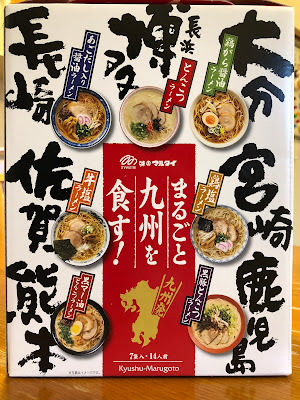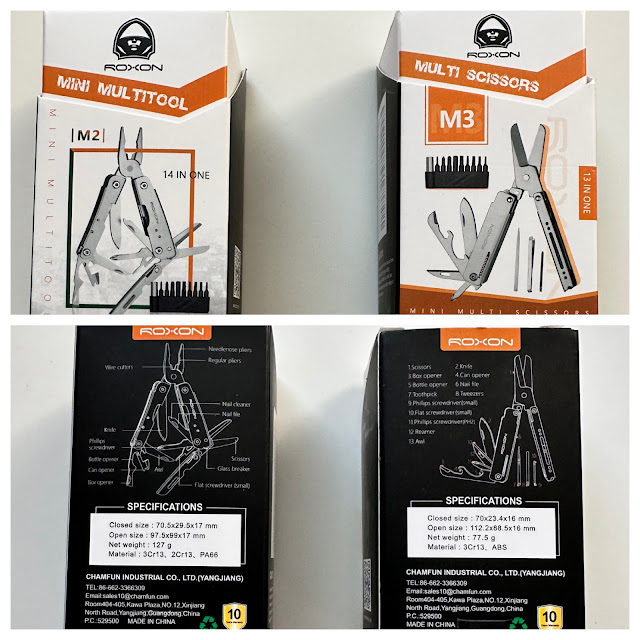We walked a block to Kamakura Station, after stopping for lunch. Needing additional resupply, we looked for a konbini to buy some drinks before heading to the Enoden (electric railroad with old fashioned trains).
 |
| Large selection of biscuits, chocolate, and candy at the konbini. There is always something to tempt you. |
 |
| Top: Lots of tea drinks to go. Bottom: While looking for a konbini, we found Kentucky Fried Chicken. The Colonel is decked out in his Santa suit. KFC is a big for Christmas in Japan. Japanese families order buckets of chicken in advance with drinks, sides, and even Christmas Strawberry Shortcake. |
Afterward, we went over to the west side of the station via an underpass to get to the Enoden line from the main train line. The Enoden is a pretty cool, local train that runs down to Enoshima and is a very picturesque and rattly way to get around along the coast. There is always a big crowd of people waiting for it as they don't run every 5 minutes.
 |
| Top: Clocktower on the side of the station with the Enoden. Bottom: Enoden line platform. You can see the old fashioned train car. |
Enoden Train from Kamakura to Hase
The Endoen runs on a single track that is basically like a single lane road. On either side, you are looking into people's backyards and admiring the laundry they have out to dry. It is a very cozy experience as the trains are often full too.
 |
| Looking out the front of the train. |
Daibutsu Great Buddha
It is half kilometre walk to the Great Buddha from Hasedera Station. You basically follow the crowds straight up a shopping street to the temple. While we were heading there the Japan Classic Car rally drove by and we were seeing all of these vintage cars passing us too.
 |
| Car Rally Posters |
 |
| Rally car. |
We were greeted by chanting monks when we arrived at Kotokuin Temple. They were asking for alms and we donated a few hundred yen. The rhythmic chanting of the monks definitely added to the atmosphere at the Great Buddha. The Daibutsu is a 93 ton bronze statue of the sitting Amida Buddha, that has a height of 13.35 metres. This bronze Buddha is the second tallest in Japan, with the taller one in Todaiji Temple in Nara. The statue is hollow and cast in sections which is still very impressive metallurgy. Construction of the statue was completed in 1252, almost 800 years ago again. The Buddha was originally housed in a wooden building that was destroyed by storm and tidal wave, so it has been in the open since 1495.
 |
| Top: The Great Buddha with the crowds in front of it. Bottom: Closeup of the great bronze face. |
 |
| Great Buddha and a bronze flower in the foreground. |
 |
| The body of the Buddha is hollow, with air vents in the back. You can pay a tiny extra fee to enter inside the Buddha. There they have some displays describing how the statue was built. |
Hasedera Temple
This Buddhist Temple is a very pretty one in the western edge of Kamakura. From its grounds in the hillside, you can get great views of the coast and the bay. This is a very prosperous temple too from the upkeep of the grounds. This temple is famous for its tall statue of Kannon, the goddess of mercy. The statue of Kannon stands nine metres tall, is covered in gold leaf, and is one of the largest wooden statues in Japan. There is also a small museum that shows some of the temple's treasures including a golden statue of Amida Buddha.
 |
| Kannon-do Hall housing the Kannon statue. |
 |
| Tiny Bamboo Grove by prayer wheel building. |
 |
| Statue of Sho-kannon Bosatsu in front of the museum. |
By this time we were actually getting worn out by being on our feet all day. We probably didn't spend as much time as we would like here, but the afternoon was fading away on us. You can tell from some of the pictures the sun is getting low in the sky. Temples start closing at 5 PM so you have to rush at this point.
 |
| View to the bay from Hasedera. |
 |
| Pond at Hasedera. |
Zeniarai Benten Shrine
After a brief walk back to Hasedera Station, we took the Enoden back to Kamakura. I wanted to visit one more shrine that day. This one was the wonderfully quirky shrine to Zeniarai Benten up in the hills about a two kilometres NW of Kamakura Station. I tried to hail a cab, but the driver kept saying he couldn't go to the shrine. Fortunately, a gate attendant, who had helped us earlier, was able to let us know that the cab could only go to the base of the hill which was why he wouldn't go. It wasn't a long walk in the end, but the shrine entrance is half-way up a hill, which can be tough at the end of a day. Walking there took us by a cool looking Starbucks and we also briefly admired some woodwork being done by carpenters at another store (they were doing nice join work).
The entrance to the shrine is a tunnel / cave cut through a hillside into a little valley beyond. It is a very cool entrance. Zeniarai Benten is an unusual shrine that fuses together Buddhist and Shinto rituals in one place. You can find Buddhist Shrines with a small Shinto Shrine inside them, but not functioning together as a whole. This is a popular shrine where people go to wash their money in the sacred spring to double it. I've even saw a commercials on TV with 7-11 giving away lucky money washed at the shrine. This shrine dates back to the Kamakura period again. The first shogun had the shrine built after a dream where a god told him to build it to bring peace. Later the shrine was also dedicated to a Buddhist goddess of snakes as the dream happened on the day of the snake in the year of the snake.
 |
| Entrance to Zeniarai Benten Shrine |
After entering the shrine there is a small complex of buildings, gates, incense burners, etc. There is the ritual water cleansing for the Shinto portion here too. You can then pay 200 yen for the buddhist portion of the shrine to get a basket for washing your money in, a votive candle, and a bundle of incense sticks to burn. You light the candle and place in on an altar rack with dozens of other little candles, then light the incense and place it in the giant burner. Finally, you enter the grotto with the sacred spring in it where you can wash the money in a more Shinto style ceremony.
 |
| Images from inside the grotto. It can get full. In the bottom picture, you can see people taking ladles of water to pour over their money in the baskets. |
 |
| Anothe portion of the sacred grotto. |
 |
| Basket, small votive candle, and bundle of incense. |
I washed some coins, but I realized afterwards that I should have washed my Canadian $20 bills which are made of plastic - it is easy to dry that kind of money afterwards! This was a really different and fun kind of shrine visit like none of the other shrines I have been to. With our water washing ritual behind us, the shrine office basically was closed when we left, we headed back to Kamakura Station and the train back to Tokyo.
Part One of Kamakura Highlights.
Follow me on Twitter a
@Tostzilla or my
feedburner for this blog.
More Tokyo / Japan Travelogue Posts.






























Comments
Post a Comment